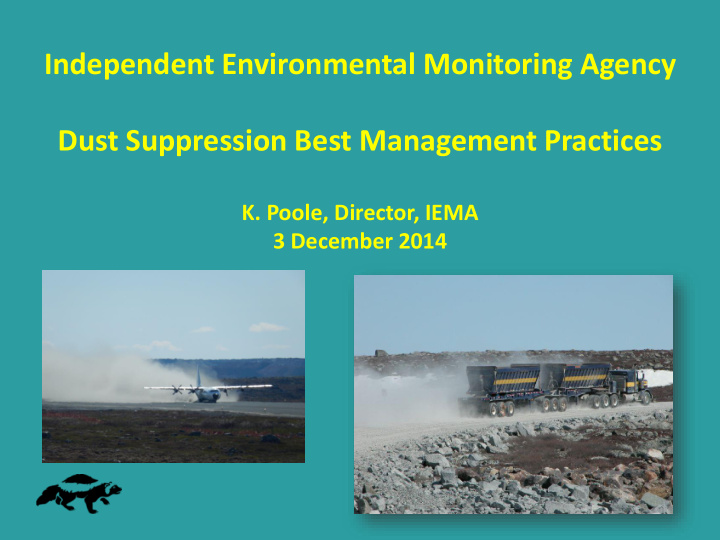



Independent Environmental Monitoring Agency Dust Suppression Best Management Practices K. Poole, Director, IEMA 3 December 2014
Zone of Influence • Boulanger et al. 2012 – 14 km ZOI (Zone of Influence) around Ekati-Diavik • ZOI: area within which caribou abundance is less than would be expected from habitat alone Red boundary = 14 km
Mechanism • Dust (response of ungulates (caribou) to dust on forage or food)
Mechanism • ZOI aligns with outer boundaries of dust (TSP – total suspended particulate) deposition Rescan (2006)
Traditional Knowledge • The communities have also told IEMA that dust could be the cause of the observed ZOI • Dust was also identified as a concern at the January 2013 Caribou Gathering
Dust Management • Reduce traffic • Reduce speed (60 to 30 kph = up to 65% reduction) • Improve road design – puddles float fine particles • Reduce exposed ground – gravel • Slow the wind – wind breaks
Dust Suppression • Why use? – Safety – visibility on the road – Health – inhaling dust – Vegetation – affects habitat (and caribou?) – Aquatic resources – Road maintenance costs – Aesthetics
Permitted Dust Suppression • GNWT ENR • Govt. of Nunavut Dept. of Environment – Water – Water – Calcium chloride – Calcium chloride – DL 10 – DL 10 – EK-35? – EK-35 – DUST-STOP
Dust Suppression Options • Water – Generally effective <12 hrs – Salt water more effective than fresh water • Calcium chloride – Salt-based – Water attractant – draws moisture out of air – Toxic to some plants – May be an attractant to ungulates
Dust Suppression Options • DL 10 – Asphalt product, mixed with water and soap solution – 30 m setback from bridges • EK-35 – Synthetic organic dust control product – Approved for airstrips • DUST-STOP – Proprietary modified cellulose blend: a mineral based component and a starch based polymer derivative
Fugitive Dust Best Management Plan 1. Identify Source (unpaved road) 2. Identify Composition of Dust 3. Description of Fugitive Dust control 4. Schedule for Implementation 5. Implementation Approach and Training 6. Inspection and Maintenance Procedures 7. Record Keeping to Verify Compliance
Fugitive Dust Best Management Plan 3. Description of Fugitive Dust control o Watering; o Chemical dust suppressants if needed; o Enforcement of speed limits; and o Roadway maintenance and clean-up procedures.
Fugitive Dust Best Management Plan 4. Schedule for Implementation o Daily visible inspections of roadways o Weekly inspections of the roadway surfaces o Appoint qualified and trained on-site dust control supervisor o Record keeping – observations and mitigation
Fugitive Dust Best Management Plan 6. Inspection and Maintenance Procedures o Daily during moderate weather conditions, and twice daily on hot dry days (<0.25 mm of rainfall for the preceding 24 hours and a temperature >20 Celsius); o Mitigation hinges on easy visual observations of dust plumes, not delayed measurements.
Fugitive Dust Best Management Plan Plume Size Measure Corrective Action Large More than 3 times Watering on haul and the size of the truck access roads. Moderate 2-3 times the size Limited watering of haul of a truck roads and high traffic areas. Small Same size as truck Repeat visual inspection within 2 hours No Plume Smaller than half None the height of the tires
THANK YOU! Questions/Comments? Independent Environmental Monitoring Agency Telephone: (867) 669-9141 Fax: (867) 669-9145 Email: monitor1@yk.com Website: www.monitoringagency.net
Recommend
More recommend